| |
Ragtime Music in
Canada
Chapter 3:
Canadian Ragtime Publishers and Record Producers
By Ted Tjaden
[return to
Table of Contents] [go to
Chapter 4]
One indication of the
popularity of the piano and parlour
entertainment during the early 1900's in
Canada is the relatively large number of
Canadian sheet music publishers and the variety of sheet music they
published. Canada and Canadians also played
a leading role in producing early recorded
music, some of which included ragtime. Set
out below on this page is more information
divided into the following three topics:
a)
Canadian
sheet music publishers during the ragtime era
b) Canadian record
producers during the ragtime era
c) Sampling of ragtime era
recordings
a) Canadian
sheet music publishers during the ragtime era
For the
period from 1900 to 1920, the market for sheet
music in Canada was particularly strong:
Most
works were either songs with piano accompaniment
or short character pieces for solo piano. Music
at this time was one of the favourite parlour
activities, and such songs and piano pieces
provided many hours of happy entertainment for
performers and listeners alike .... The reason
behind the remarkable quantity of music
publishing was simply that in this period it
made money, since musical scores of the type
described were extremely marketable. So also
were pianos: there were approximately thirty
pianos manufacturers in Canada prior to 1914,
compared with fewer than half a dozen sixty
years later. (Proctor 1980:3)
Melhuish
(1996:33) reports that Geoffrey O'Hara's "K-K-K-Katy
(The Stammering Song)" (see the sheet music for this
song), which was written in Kingston,
Ontario, sold over one million copies in sheet
music form.
Since
there were relatively few "pure" rags written and
published in Canada, there was no single publisher
of ragtime music per se; instead, we can
observe that there were a number of Canadian
publishers who appear to have published the bulk
of ragtime and similar syncopated marches and two
steps and other ragtime-related music during this
period:
- Anglo-Canadian
Music Company: According to The Canadian
Encyclopedia, the Anglo-Canadian
Music Company was established in London in
1885 with a branch set up in Toronto for the
purpose of printing and selling British music
copyrights in Canada. By doing so, due to arcane
provisions in the Canadian Copyright Act at
that time, the company could stop American
publishers from trying to import pirated copies
of music into Canada. Although most composers of
sheet music published by the company were by
British or European composers, the company did
start to publish songs by Canadian composers in
the late 1890's.
- HH
Sparks: One of the main publishers
of ragtime and ragtime-related music in Canada
was HH
Sparks Music Co, established in Toronto in
1900 by Harry H Sparks. In the decade or so it
remained in business, it issued over 200 pieces
of music (according to its
entry in the The Canadian
Encyclopedia. Joseph F Lamb
was a major composer for HH Sparks, as was
Arthur Wellesley Hughes.
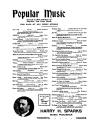
Image source:
Library
and Archives Canada
|
Left: Sample
advertisement from 1904 for sheet music
published by HH Sparks (with,
presumably, a picture of HH Sparks in
the lower left corner). Although there
are no ragtime pieces advertised, there
are several two-steps and marches, in
addition to the standard, likely
maudlin, fare of ballads and sacred
songs. Note that this advertisement
includes the Celestine Waltzes
by Joseph Lamb (click here for
this piece).
Source: Advertising page
from the back of The Elephant Trot
by Karl Kahn (Toronto: HH Sparks,
1904) (right).
|

Image
source:
Library
and Archives Canada
|
- Le
Passe-Temps: Le
Passe-Temps was a periodical
published in Montreal from 1895 to 1949 and,
according to its
entry in The Canadian
Encyclopedia, covered stories
relating to music, literature, theatre, fashion,
and sports. Many of the ragtime music and
marches and waltzes of JB Lafrenière were
published in Le Passe-Temps.
- Whaley
& Royce: In addition to manufacturing
and selling musical instruments (including
pianos), Whaley,
Royce & Co Ltd also published and sold
music. The Canadian
Encyclopedia suggests that their
advertising slogan of "Canada's Greatest Music
House" was probably justified due to their large
inventory of music and musical instruments. The
company had its own engraving, lithographing and
printing facilities and also published music
magazines. According to its
entry in The Canadian Encyclopedi,
the "first Whaley, Royce publications date from
1890. The catalogue grew quickly and during the
next 30 years surpassed that of any other
Canadian publisher. The output declined later
and came to a halt about 1940, after which date
only reprints of earlier issues were undertaken,
and a very few new items."
- WH
Hodgins & Co: According to The Canadian
Encyclopedia, WH
Hodgins & Co, based in Toronto,
published around 100 sheet music titles of
dance, march and popular song tunes. From 1897
to 1900, the pieces are published under the name
"Amey & Hodgins," while from 1900 to 1907,
they are published by WH Hodgins & Co. As an
individual, WH Hodgins was a major composer for
the company (see Chapter 8 for copies of
the sheet music for compositions he wrote as an
individual).
The names
of other publishers of ragtime-related music in
Canada include The Northern Music Company,
Imperial Music Pub House, and JE Belair, but
unfortunately, not much information is easily
available about these publishers.
b) Canadian
record producers during the ragtime era
Canada
was at the forefront of early record producing
during the ragtime era. Emile Berliner, who had
established the gramophone in the United States in
1893, established a new Canadian company (E
Berliner) in Montreal in 1899 to produce
gramophones in Canada based on a patent for
gramophones he filed in Canada in 1897. Later,
Herbert Berliner, eldest son of Emile Berliner,
established The Compo Company Ltd in Lachine
Quebec in 1918.
For a
fascinating look at the history of both companies,
see "The
History of Recorded Sound in Canada" from
The
Virtual Gramophone
(Collections Canada). The site also has a
huge database of ragtime era recordings (in .mp3
format), although most of them are not rags
but instead represent a broad spectrum of
(Canadian) music recorded by these companies at
the time.
On a
related note: Do you know the connection
between the name of HMV (the music
store) and Emile Berliner? According to Melhuish (1996:30), Emile
Berliner registered a Canadian trademark in 1900
of Nipper,
the fox terrier, looking down the horn of a
phonograph. This trademark was later used by
Victor Talking Machine Co and inspired the naming
of "His Master's Voice" records, the initials to
which are "HMV." Now you know.
c) Sampling
of ragtime era recordings
Set out
below in chronological order are a selected
example of recordings by Canadian performers or
producers from the ragtime era:
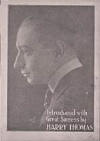 |
Harry Thomas,
A Classical Spasm (.mp3)
(Camden, NJ: Victor, 1917)
Source:
The
Virtual Gramophone
(Collections Canada) [top]
|
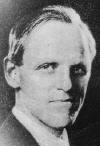 |
Geoffrey O'Hara singing the Canadian
wartime patriotic song Doughboy
Jack and Doughnut Jill
(by Gitz Rice) (.mp3),
with Willie Eckstein on piano (Montreal,
QC: Berliner Gram-O-Phone Co, 1919)
Source:
The
Virtual Gramophone
(Collections Canada) [top]
|
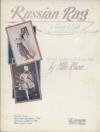 |
Listen to: George Cobb's Russian
Rag (.mp3)
played by the Waldorf-Astoria Dance
Orchestra (Montreal, QC: Berliner
Gramophone, 1920)
Source:
The
Virtual Gramophone
(Collections Canada)
Download
sheet music: Indiana
University Sheet Music Collections [top]
|
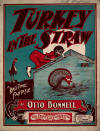 |
Willie Eckstein, Turkey
in the Straw (.mp3)
(Lachine, QC: Compo Company Limited, 1923)
Source:
The
Virtual Gramophone
(Collections Canada)
Download
sheet music: The
Lester S Levy Sheet Music
Collection [top]
|
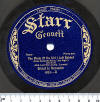 |
Listen to: The Dumbells, The
Photo of the Girl I Left Behind
(.mp3)
(London, ON: Starr Company, 1924)
Source:
The
Virtual Gramophone
(Collections Canada) [top]
|
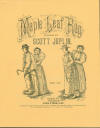 |
Listen to: Vera Guilaroff, Maple
Leaf Rag (.mp3)
(Lachine, QC: Compo Company Limited,
1926)
Source:
The
Virtual Gramophone
(Collections Canada)
Download
sheet music: Indiana
University Sheet Music Collections [top]
|
In the next chapter, I briefly
discuss the history of piano manufacturing in
Canada.
[return to Table of
Contents] [continue to
Chapter 4] [top]
|
|







